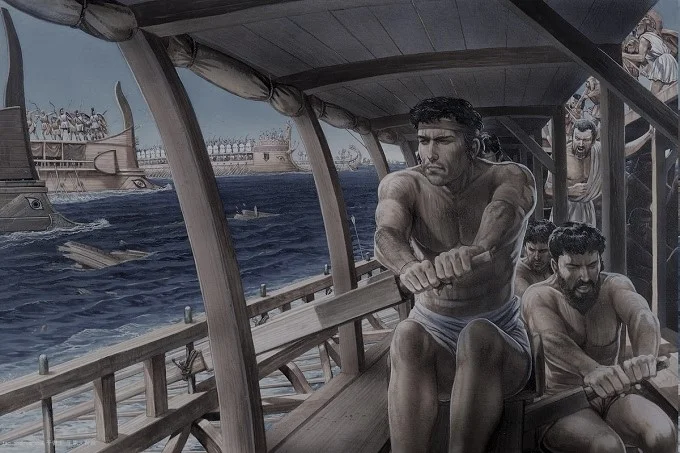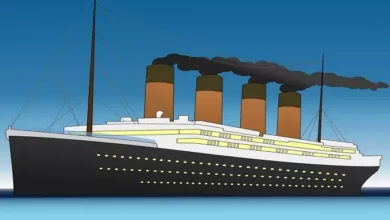The truth about Galley slaves and their participation in naval battles

The first ship’s propulsion was, apparently, an oar. A little later, a sail was added to it, but at first, it was used only as an auxiliary option with a fair wind, since it is somewhat more difficult to manage it.
The sail simplified the life of shipbuilders, but it was not immediately useful in the war. It was suitable for transports and merchants, but not quite for the navy. Of course, the military did not refuse the sail and used it during transitions, but in battles for many centuries, warships rowed – simply because of independence from the wind, better maneuvering, and ease of control – it was possible to give voice commands without resorting to ingenious mechanical devices simply. In addition, the maneuverability of a sailboat is influenced by a lot of factors: the area of the sail, its design, the contours of the hull, the design of the mast and rigging, and a number of others.
It is not surprising that until the XV century, rowing vessels remained the main force of military fleets. And even later, the galley fleet was preserved as an auxiliary until the most developed XVIII century. We should also not forget about sailing-rowing hybrids for actions in shallow water and patrol service.
The difficulty of the rowing engine is that it is extremely voracious – a lot of rowers needed to be fed and watered (this is generally the main thing), otherwise they simply will not be able to perform the tasks assigned to them. But at the same time, you can’t load a lot of supplies on a rowing vessel – either you will have to weaken the power (reduce the number of rowers), or increase the completeness of the contours, which will cause the speed to be lost. And rowing vessels (let’s call them conditionally “galleys” for simplicity, since everything is the same: both Greek triremes and Spanish galleasses are, in fact, closest relatives) never differ in seaworthiness due to insurmountable design features. And therefore, they are suitable only for coastal showdowns in shallow water.
For example, during the First Punic War, the Romans did not have time to hide from the storm, which caused them to lose almost their entire rather large fleet, and, according to some estimates, 15% of all Roman men of that time, who were considered liable for military service, simply drowned – terrible non-combat losses even for such a powerful empire (80 out of 364 ships survived).
In the time of Peter the Great, a little after the Gangut victory, the Russian galley fleet was caught in a storm in the Gulf of Bothnia, in which a third of all available galleys sank. Well, more people died at the same time than in the battle itself.
And the galleys turned out to be sensitive to the quality of the crew. For a very simple reason – their driving and maneuvering qualities in battle directly depended on the training and endurance of the rowers.
There is a misconception that only slaves turned oars on the galleys. But sources say that slaves were not trusted with such responsible combat posts. And only freelance free citizens worked on the oars.
Those who received a rather large salary – this work was so highly valued. Very often, rowers were also regarded as a mandatory force for boarding combat. Actually, both the Greeks and the late Vikings, and even the Spaniards had warriors sitting on the rowers’ bench – such a prototype of a marine who was also engaged in work on the ship. For example, quite a free tragedian Aeschylus was present at the Battle of Salamis precisely as a rower of the Athenian fleet (and together with his brother), which did not prevent him from taking part in hand-to-hand combat for Persian ships (in which Aeschylus’ brother died).
For the first time, slaves were allowed to row on galleys by the Romans. But that was a necessary measure in case of war. There just weren’t enough crews, so they had to connect non-free ones. True, only for agreeing to risk his life in a naval battle, a slave was entitled to freedom, and no one dragged him forcibly to the ship – they went themselves, exclusively voluntarily. To get the latest stories, install our app here.
Much later, the Turks, fighting with the Italian city-republics, began to equip the crews of galleys with slaves. Although this solution created a lot of additional problems – slaves had to be chained, and there was no need to talk about a resource for hand-to-hand combat. Well, there were problems with discipline, not to mention the hygienic aspect of the habitability of the ship’s space. The example of the Turks was followed by the Venetians, but very reluctantly and limited – nevertheless, free rowers turned out to be more effective.
By the way, the work of rowers was not considered humiliating or second-rate. It is only worth noting that in Ancient Rome, service in the navy was less prestigious than in the land legions, but mostly galley rowers were treated with respect.
Interestingly, not so long ago, during excavations in Kerch, a strange burial belonging to late Antiquity was found. Skeletons of men of different ages were found on the territory of an ancient city dump, rather carelessly buried in several graves (not always individual). And the bones of these poor fellows were distinguished by traces of common pathologies – disproportionately developed upper half and weak legs.
Moreover, there were also traces of an ailment caused by chronic dampness and cold on the legs. Given that only very long-term environmental factors are reflected on the bones, some scientists are inclined to think that these are galley slaves. But the trouble is that nothing is known about them at that time, and sources rather claim that such a phenomenon is impossible. Therefore, for now, we have to write this strange fact into riddles. To get the latest stories, install our app here.




